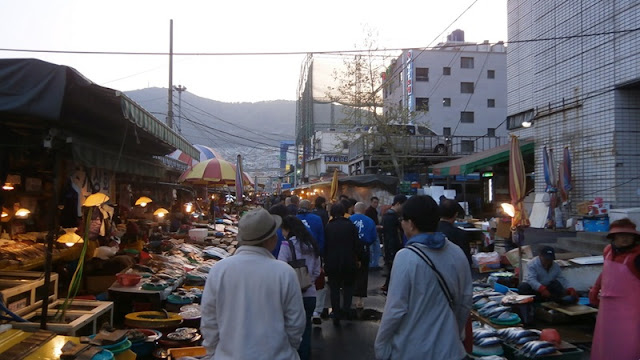Bas yang kami naiki berhenti di stesen bas ekspress di Gyeongju. Pemandu bas tu akan sebut beberapa kali destinasi yang kami tuju dan hampir semuanya turun.
Kami sengaja pilih berada di seat hadapan bas kerana ada dua sebab utama iaitu dapat menghayati perjalanan melalui pemandangan yang lebih jelas dan sebarang makluman dari pemandu dapat didengar dengan jelas yang mana pemandu bas berada betul-betul di hadapan kami.
Kami ke Gyeongju bersama-sama dengan backpack dan beg pakaian masing-masing kerana pada hari tersebut kami akan check-in hostel di Haeundae Beach selepas pulang dari lawatan seharian di Gyeongju. Kami tidak bermalam di Gyeongju. Jadi, macam mana nak berjalan dengan beg segala bagai tu?
Kami ambil keputusan cari rak berbayar atau khidmat letak beg di Gyeongju. Mujur di stesen bas tersebut ada menyediakan rak/tempat penyimpanan beg, seperti yang aku jangkakan.
Tempat penyimpanan beg kami pilih rak/locker yang paling besar. Maka muatlah semua beg kami berdua. Sebenarnya, kami agak terkial-kial juga bagaimana menggunakan locker automatik tu, dan nasib menyebelahi kami kerana ada orang korea yang sudi membantu.
Tidak jauh daripada terminal bas yang tidak seberapa besar tu, ada pondok tourist information. Di situ lah kami ambil peta dan bertanyakan cara untuk ke Bulguksa Temple.
Kemudian, kami menunggu di satu bus stop yang berada tidak jauh dari pondok informasi itu seperti yang disarankan oleh petugas tadi.
Bas yang disyorkan adalah #10, #11 atau #700. Kalau tak silap aku, kami naik bas no. 11. Perjalanan ke Bulguksa agak jauh juga kira-kira hampir 30 minit dari bas stop yang berada bersetentang dengan terminal bas Gyeongju itu.







Kami sengaja pilih berada di seat hadapan bas kerana ada dua sebab utama iaitu dapat menghayati perjalanan melalui pemandangan yang lebih jelas dan sebarang makluman dari pemandu dapat didengar dengan jelas yang mana pemandu bas berada betul-betul di hadapan kami.
Kami ke Gyeongju bersama-sama dengan backpack dan beg pakaian masing-masing kerana pada hari tersebut kami akan check-in hostel di Haeundae Beach selepas pulang dari lawatan seharian di Gyeongju. Kami tidak bermalam di Gyeongju. Jadi, macam mana nak berjalan dengan beg segala bagai tu?
Kami ambil keputusan cari rak berbayar atau khidmat letak beg di Gyeongju. Mujur di stesen bas tersebut ada menyediakan rak/tempat penyimpanan beg, seperti yang aku jangkakan.
Tempat penyimpanan beg kami pilih rak/locker yang paling besar. Maka muatlah semua beg kami berdua. Sebenarnya, kami agak terkial-kial juga bagaimana menggunakan locker automatik tu, dan nasib menyebelahi kami kerana ada orang korea yang sudi membantu.
Tidak jauh daripada terminal bas yang tidak seberapa besar tu, ada pondok tourist information. Di situ lah kami ambil peta dan bertanyakan cara untuk ke Bulguksa Temple.
Kemudian, kami menunggu di satu bus stop yang berada tidak jauh dari pondok informasi itu seperti yang disarankan oleh petugas tadi.
Bas yang disyorkan adalah #10, #11 atau #700. Kalau tak silap aku, kami naik bas no. 11. Perjalanan ke Bulguksa agak jauh juga kira-kira hampir 30 minit dari bas stop yang berada bersetentang dengan terminal bas Gyeongju itu.
 |
| Bulguksa temple. Susahnya nak ambil gambar ni tanpa kehadiran orang lain interprem dalam gambar! |
Bas yang kami akan berhenti di suatu dataran. Kami kena menapak naik bukit sikit untuk ke bulguksa temple dan jaraknya tidak terlalu jauh sangat, Lagi pun tak terasa jauh kerana teruja melihat pohon-pohon bunga yang cantik di tamannya sebelum sampai ke situ!



Kalau naik kereta sendiri atau sewa, boleh terus sampai ke pintu masuk Bulguksa temple ni. Ada tempat parkir kenderaan di kawasan yang disediakan pihak bulguksa temple.




Nampak tak pintu gerbang kat atas ni? Kat situ merupakan pintu masuk dan bayaran dikenakan sebanyak 4,000 won. Ketika kami sampai, dah ramai manusia mula berpusu-pusu beratur masuk.
Sebaik sahaja pelawat melepasi pintu masuk, akan kelihatan kolam yang menawan ni. Belum sampai ke temple, pemandangan dah cukup mengasyikkan.
Dari laluan redup dan mendamaikan mata tu, akan melalui satu pintu gerbang. Semacam pintu pagar masuk ke kawasan temple yang sebenar.
Dan, kami jumpa kepingan-kepingan yang bertulis sesuatu. Tak tahu motifnya. Tapi macam menarik juga dan ada juga orang pergi ke pondok yang letaknya kepingan-kepingan genting tersebut.
Kedai cenderahati juga ada di situ. Aku ada ushar tapi tak berapa minat nak beli. hehehe.. Dan ada juga semacam kolah. Budak-budak kat bawah ni sibuk mencebok air tu. Fungsinya jangan tanya aku!
Setiap jalan/laluan ada signboard yang lengkap. Jangan risau kalau tersasar laluan atau sesat.
OK. Jom beredar. Bulguksa temple ni kira okey juga la. Aku lebih fokus kepada persekitaran, sejarah dan senibinanya sahaja. Tak tau la motif orang lain datang ke sini.
Sebelum meninggalkan bulguksa, aku dah prepare 'sesuatu'. Aku nak bergambar dengan cherry blossom kat korea selatan ni walaupun aku tahu sebenarnya kehadiran kami di sana hampir semua cherry blossom dah gugur.
Aku berharap di Gyeongju sempat dengan cherry blossom. Tapi nan-hado juga. Walaupun begitu, aku bertuah bila ke Bulguksa Temple sebab ada bunga yang indah juga (bukan cherry blossom). Bak kata pepatah, tiada gading tanduk berguna juga!
Jadi aku berbaju melayu bergambar di taman yang kami sampai sebelum ke pintu bayaran masuk tadi. Tukar baju kat toilet yang tak jauh dari taman. Orang korea pandang pelik je aku pakai baju melayu tapi aku buat tak tahu sahaja. Hiks!
Jom, jom.. gambar berbaju melayu tu banyak sebenarnya. Aku letak satu je lah.. hehe. Sudah, kita pergi ke tempat lain pulak!
Kami ke destinasi seterusnya naik bas #700. Tunggu kat tempat sama ketika kami turun tadi. Nak tahu kami ke mana? Ikutilah kisah seterusnya.
Bersambung..





















































